DETERMINANTS OF FDI IN TRANSITION ECONOMIES IN SEE COUNTRIES AND
Determinants of FDI in transition economies in SEE Countries and its effect in the income inequality
81 Pages18986 Words2 Views
Added on 2022-11-13
About This Document
I made already a draft and i would like to be considered that this draft will change according to your recommendations and my tutor recommendations. I would like to have a weekly report about the progress of my master thesis. SEE means South East European countries. Attached is the ppt that i sent to my tutor. If you will need informations related to some SEE countries that are found only in their native language i will try to do my best in order to provide them.
DETERMINANTS OF FDI IN TRANSITION ECONOMIES IN SEE COUNTRIES AND
Determinants of FDI in transition economies in SEE Countries and its effect in the income inequality
Added on 2022-11-13
ShareRelated Documents
Running head: DETERMINANTS OF FDI IN TRANSITION ECONOMIES IN SEE
COUNTRIES AND ITS EFFECT IN THE INCOME INEQUALITY
Determinants of FDI in Transition Economies in SEE Countries and its Effect in the Income
Inequality
Lorisa Dimo
Tokyo International University
Course ID
COUNTRIES AND ITS EFFECT IN THE INCOME INEQUALITY
Determinants of FDI in Transition Economies in SEE Countries and its Effect in the Income
Inequality
Lorisa Dimo
Tokyo International University
Course ID
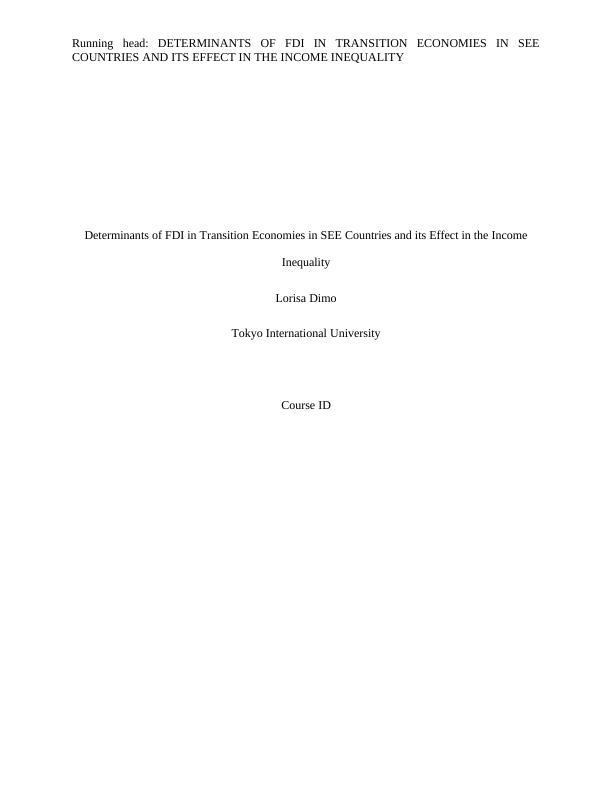
DETERMINANTS OF FDI IN TRANSITION ECONOMIES IN SEE COUNTRIES AND
ITS EFFECT IN THE INCOME INEQUALITY
1
Table of Contents
Chapter 1: Introduction....................................................................................................................5
1.1 Background of the study...................................................................................................5
1.2 Overview of the selected economy........................................................................................6
1.3 Performance of the selected economies on different economic indicators..........................10
Foreign Direct Investment.....................................................................................................10
Gross Domestic Product........................................................................................................11
Inflation rate...........................................................................................................................12
Unemployment rate...............................................................................................................13
Trade openness......................................................................................................................14
1.4 Problem statement...............................................................................................................15
1.5 Aim of the study..................................................................................................................16
1.6 Objectives of the study........................................................................................................16
1.7 Research questions...............................................................................................................17
1.8 Research hypotheses............................................................................................................17
1.8.1 Hypothesis 1.................................................................................................................17
1.8.2 Hypothesis 2.................................................................................................................17
1.9 Structure of the study...........................................................................................................18
Chapter 2: Literature Review.........................................................................................................19
2.1 Introduction..........................................................................................................................19
ITS EFFECT IN THE INCOME INEQUALITY
1
Table of Contents
Chapter 1: Introduction....................................................................................................................5
1.1 Background of the study...................................................................................................5
1.2 Overview of the selected economy........................................................................................6
1.3 Performance of the selected economies on different economic indicators..........................10
Foreign Direct Investment.....................................................................................................10
Gross Domestic Product........................................................................................................11
Inflation rate...........................................................................................................................12
Unemployment rate...............................................................................................................13
Trade openness......................................................................................................................14
1.4 Problem statement...............................................................................................................15
1.5 Aim of the study..................................................................................................................16
1.6 Objectives of the study........................................................................................................16
1.7 Research questions...............................................................................................................17
1.8 Research hypotheses............................................................................................................17
1.8.1 Hypothesis 1.................................................................................................................17
1.8.2 Hypothesis 2.................................................................................................................17
1.9 Structure of the study...........................................................................................................18
Chapter 2: Literature Review.........................................................................................................19
2.1 Introduction..........................................................................................................................19
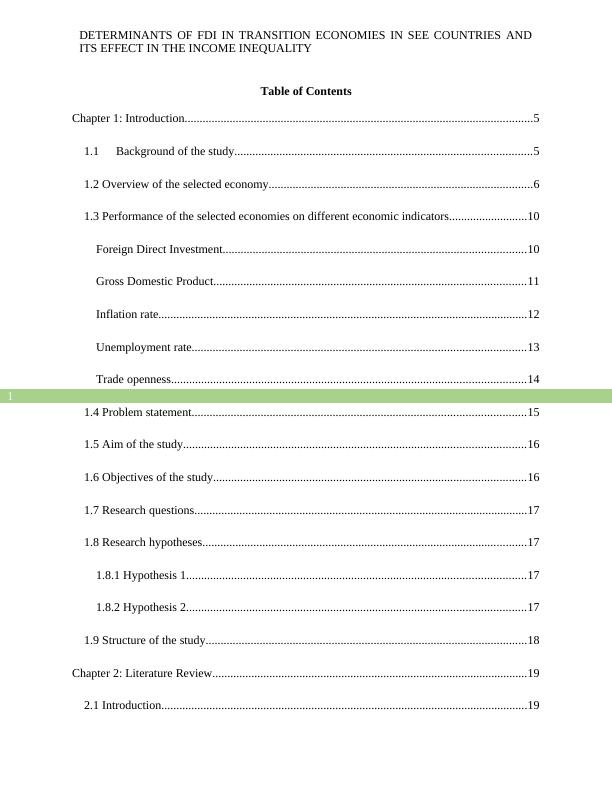
DETERMINANTS OF FDI IN TRANSITION ECONOMIES IN SEE COUNTRIES AND
ITS EFFECT IN THE INCOME INEQUALITY
2
2.1 Foreign Direct Investment...................................................................................................19
2.2 Theoretical background of determinants of FDI.................................................................20
2.3 Determinants of Foreign Direct Investment........................................................................21
2.3.1 Market size....................................................................................................................21
2.3.2 Trade openness.............................................................................................................22
2.4 FDI and Income Inequality..................................................................................................23
2.5 Factors affecting income inequality.....................................................................................27
2.5.1 Inflation and its effect on Income Inequality................................................................27
2.5.2 Unemployment and its effect on Income Inequality.........................................................28
2.5.3 Financial Development and its effect on Income Inequality............................................28
2.5.4 Government Expenditure and its effect on Income Inequality.........................................29
2.5.5 GDP per capita and its effect on Income Inequality.........................................................29
Chapter 3: Research Methodology................................................................................................31
3.1 Introduction..........................................................................................................................31
3.2 Outline of the research method............................................................................................31
3.3 Research onion.....................................................................................................................32
3.4 Research Philosophy............................................................................................................33
3.4.1 Justification behind selection of specific research philosophy (Positivism) for the
study.......................................................................................................................................34
3.5 Research Approach..............................................................................................................35
ITS EFFECT IN THE INCOME INEQUALITY
2
2.1 Foreign Direct Investment...................................................................................................19
2.2 Theoretical background of determinants of FDI.................................................................20
2.3 Determinants of Foreign Direct Investment........................................................................21
2.3.1 Market size....................................................................................................................21
2.3.2 Trade openness.............................................................................................................22
2.4 FDI and Income Inequality..................................................................................................23
2.5 Factors affecting income inequality.....................................................................................27
2.5.1 Inflation and its effect on Income Inequality................................................................27
2.5.2 Unemployment and its effect on Income Inequality.........................................................28
2.5.3 Financial Development and its effect on Income Inequality............................................28
2.5.4 Government Expenditure and its effect on Income Inequality.........................................29
2.5.5 GDP per capita and its effect on Income Inequality.........................................................29
Chapter 3: Research Methodology................................................................................................31
3.1 Introduction..........................................................................................................................31
3.2 Outline of the research method............................................................................................31
3.3 Research onion.....................................................................................................................32
3.4 Research Philosophy............................................................................................................33
3.4.1 Justification behind selection of specific research philosophy (Positivism) for the
study.......................................................................................................................................34
3.5 Research Approach..............................................................................................................35

DETERMINANTS OF FDI IN TRANSITION ECONOMIES IN SEE COUNTRIES AND
ITS EFFECT IN THE INCOME INEQUALITY
3
3.5.1 Justification behind selection of particular research approach (Deductive) for the study
...............................................................................................................................................35
3.6 Research design...................................................................................................................36
3.6.1 Justification behind selection of particular research design (explanatory) for the study..37
3.7 Data collection process........................................................................................................38
3.8 Selection of variables...........................................................................................................39
3.9 Model Specification.............................................................................................................43
Secondary data collection......................................................................................................49
3.10 Sampling and sample size..................................................................................................49
3.11 Data analysis......................................................................................................................50
3.12 Ethical consideration.............................................................................................................50
3.13 Research limitation............................................................................................................51
3.14 Summary............................................................................................................................51
Chapter 4: Result and Discussion..................................................................................................52
4.1 Result...................................................................................................................................52
4.1.2 Determinants of Foreign Direct Investment.....................................................................53
4.1.3 Impact of FDI on inequality.............................................................................................59
4.2 Discussion............................................................................................................................63
4.2.1 Hypothesis 1: Relation between FDI and different determinants in Southeastern
European Transition Economies................................................................................................63
ITS EFFECT IN THE INCOME INEQUALITY
3
3.5.1 Justification behind selection of particular research approach (Deductive) for the study
...............................................................................................................................................35
3.6 Research design...................................................................................................................36
3.6.1 Justification behind selection of particular research design (explanatory) for the study..37
3.7 Data collection process........................................................................................................38
3.8 Selection of variables...........................................................................................................39
3.9 Model Specification.............................................................................................................43
Secondary data collection......................................................................................................49
3.10 Sampling and sample size..................................................................................................49
3.11 Data analysis......................................................................................................................50
3.12 Ethical consideration.............................................................................................................50
3.13 Research limitation............................................................................................................51
3.14 Summary............................................................................................................................51
Chapter 4: Result and Discussion..................................................................................................52
4.1 Result...................................................................................................................................52
4.1.2 Determinants of Foreign Direct Investment.....................................................................53
4.1.3 Impact of FDI on inequality.............................................................................................59
4.2 Discussion............................................................................................................................63
4.2.1 Hypothesis 1: Relation between FDI and different determinants in Southeastern
European Transition Economies................................................................................................63
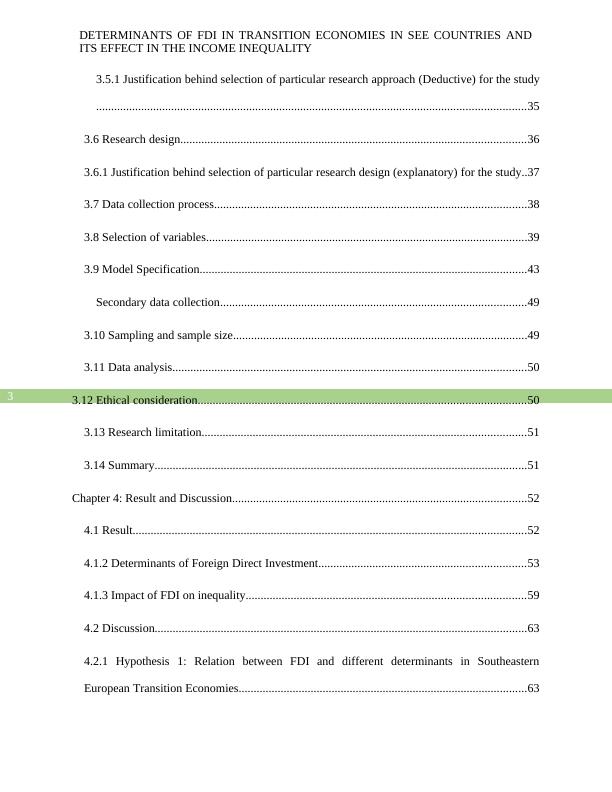
DETERMINANTS OF FDI IN TRANSITION ECONOMIES IN SEE COUNTRIES AND
ITS EFFECT IN THE INCOME INEQUALITY
4
4.2.2 Hypothesis 2: Relation between FDI and income inequality in Southeastern European
Transition Economies................................................................................................................64
Chapter 5: Conclusion and Recommendation...............................................................................67
5.1 Conclusion...........................................................................................................................67
5.2 Linking with the objective...................................................................................................67
5.3 Recommendation.................................................................................................................69
5.4 Limitation and future scope of research..............................................................................70
References......................................................................................................................................71
ITS EFFECT IN THE INCOME INEQUALITY
4
4.2.2 Hypothesis 2: Relation between FDI and income inequality in Southeastern European
Transition Economies................................................................................................................64
Chapter 5: Conclusion and Recommendation...............................................................................67
5.1 Conclusion...........................................................................................................................67
5.2 Linking with the objective...................................................................................................67
5.3 Recommendation.................................................................................................................69
5.4 Limitation and future scope of research..............................................................................70
References......................................................................................................................................71
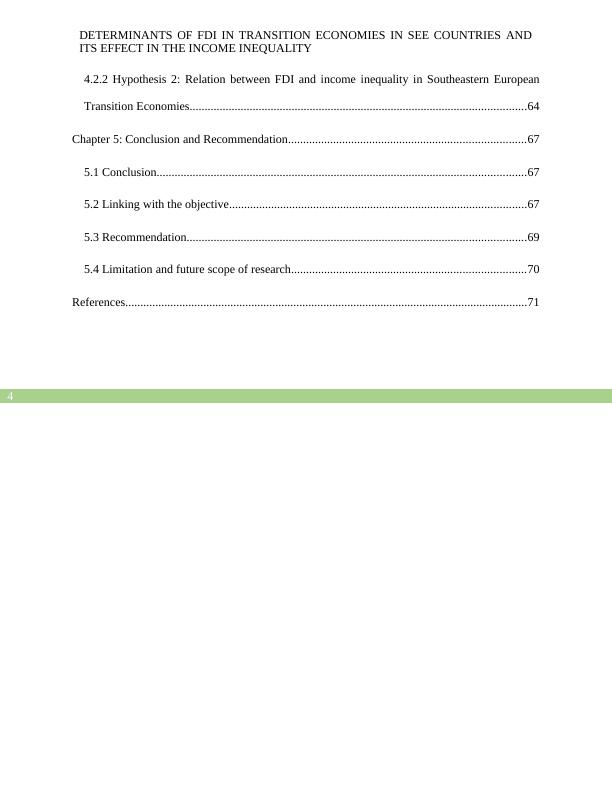
DETERMINANTS OF FDI IN TRANSITION ECONOMIES IN SEE COUNTRIES AND
ITS EFFECT IN THE INCOME INEQUALITY
5
Chapter 1: Introduction
1.1 Background of the study
Foreign Direct Investment refers to the investment made by a firm or investors in
business activities located outside the domestic economy. FDI is considered as an important
aspect for countries to enjoy the benefits arising from spread of globalization (Iamsiraroj, 2016).
Historically, Foreign Direct Investment contributed to economic development of host countries
in terms of improving infrastructure, entrepreneur abilities, technical skills and financial
resources in the form of government revenue and foreign exchange earnings. Realizing the
benefits associated with Foreign Direct Investment, demand for Foreign Direct Investment has
increased overtime especially since the last two decades. The increasing shortage of fund
approval from different international institution and foreign aids coming from developing
countries have led to an increase in demand for foreign funds in less developed countries
(Kariuki, 2015). Despite an overall increasing trend in the flow of foreign direct investment, the
distribution of foreign funds varies unevenly among different regions of world. There are
different factors that affect inflow of foreign funds in different nations. FDI inflows tend to be
higher in countries having political stability, favorable policies related to tax and subsidies, a
good environment supportive for business growth, better design of administrative policies, low
corruption level and such other supporting environment (Castellani, Meliciani & Mirra, 2016)
Additionally, there are macro variables that influence FDI flows in different nations. These
variables include market size, physical infrastructure, and availability of skilled labor force,
inflation, trade openness, productivity, unemployment, interest rate and others. Foreign Direct
Investment is considered to have a spillover effect on economic growth of host nation. With
expansion of economic growth and development of different sectors of the economy income
ITS EFFECT IN THE INCOME INEQUALITY
5
Chapter 1: Introduction
1.1 Background of the study
Foreign Direct Investment refers to the investment made by a firm or investors in
business activities located outside the domestic economy. FDI is considered as an important
aspect for countries to enjoy the benefits arising from spread of globalization (Iamsiraroj, 2016).
Historically, Foreign Direct Investment contributed to economic development of host countries
in terms of improving infrastructure, entrepreneur abilities, technical skills and financial
resources in the form of government revenue and foreign exchange earnings. Realizing the
benefits associated with Foreign Direct Investment, demand for Foreign Direct Investment has
increased overtime especially since the last two decades. The increasing shortage of fund
approval from different international institution and foreign aids coming from developing
countries have led to an increase in demand for foreign funds in less developed countries
(Kariuki, 2015). Despite an overall increasing trend in the flow of foreign direct investment, the
distribution of foreign funds varies unevenly among different regions of world. There are
different factors that affect inflow of foreign funds in different nations. FDI inflows tend to be
higher in countries having political stability, favorable policies related to tax and subsidies, a
good environment supportive for business growth, better design of administrative policies, low
corruption level and such other supporting environment (Castellani, Meliciani & Mirra, 2016)
Additionally, there are macro variables that influence FDI flows in different nations. These
variables include market size, physical infrastructure, and availability of skilled labor force,
inflation, trade openness, productivity, unemployment, interest rate and others. Foreign Direct
Investment is considered to have a spillover effect on economic growth of host nation. With
expansion of economic growth and development of different sectors of the economy income
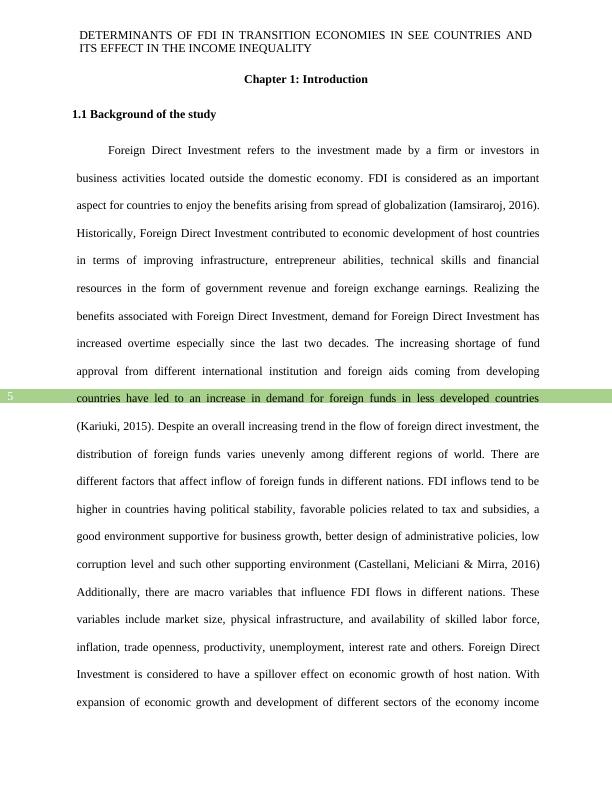
DETERMINANTS OF FDI IN TRANSITION ECONOMIES IN SEE COUNTRIES AND
ITS EFFECT IN THE INCOME INEQUALITY
6
inequality likely to decline. The extent to which income inequality decreases that depend on
sectors where the funds are allocated and utilized (Tokunaga & Iwasaki, 2017) The current
study analyzes flow of FDI and its determinants factors for the six selected South East European
countries namely Albania, Bosnia and Herzegovina, Kosovo, Macedonia, Montenegro and
Serbia. Another associated aspect discussed along with determinants of FDI is the impact of
FDI on income inequality of these nations.
1.2 Overview of the selected economy
Albania
Albania is located in Southeastern Europe bordered by Adriatic Sea and lonian Sea. The
nation is located between Montenegro and Kosovo to the north and Greece to the south. Tirana is
the capital city of the nation. The nation occupies a total area of 28,748 Sq. Km with a
population of 3.2 million. The official language of Albania is Albanian. The Gross Domestic
Product of Albania as recorded in 2018 is 13.04 USD billion. Per Capita GDP of the nation is
4544 USD. Albania has accounted a remarkable economic growth in the last three decades.
Steady growth performance of Albania has helped the nation to develop from one of the poorest
countries in Europe to the state of a middle income nation (worldbank.org., 2019). Albania
successfully lowered state of poverty almost by half during this period. Occurrence of global
financial crisis interrupted steady growth model of Albania. This highlighted the fact that the
nation need to shift from consumption and investment based growth to export-led growth.
Bosnia and Herzegovina
Bosnia and Herzegovina is another nation located in Southeastern Europe and bordered
by Adriatic Sea and Croatia. The nation covers a geographic area of 51, 187 Sq. Km. The capital
ITS EFFECT IN THE INCOME INEQUALITY
6
inequality likely to decline. The extent to which income inequality decreases that depend on
sectors where the funds are allocated and utilized (Tokunaga & Iwasaki, 2017) The current
study analyzes flow of FDI and its determinants factors for the six selected South East European
countries namely Albania, Bosnia and Herzegovina, Kosovo, Macedonia, Montenegro and
Serbia. Another associated aspect discussed along with determinants of FDI is the impact of
FDI on income inequality of these nations.
1.2 Overview of the selected economy
Albania
Albania is located in Southeastern Europe bordered by Adriatic Sea and lonian Sea. The
nation is located between Montenegro and Kosovo to the north and Greece to the south. Tirana is
the capital city of the nation. The nation occupies a total area of 28,748 Sq. Km with a
population of 3.2 million. The official language of Albania is Albanian. The Gross Domestic
Product of Albania as recorded in 2018 is 13.04 USD billion. Per Capita GDP of the nation is
4544 USD. Albania has accounted a remarkable economic growth in the last three decades.
Steady growth performance of Albania has helped the nation to develop from one of the poorest
countries in Europe to the state of a middle income nation (worldbank.org., 2019). Albania
successfully lowered state of poverty almost by half during this period. Occurrence of global
financial crisis interrupted steady growth model of Albania. This highlighted the fact that the
nation need to shift from consumption and investment based growth to export-led growth.
Bosnia and Herzegovina
Bosnia and Herzegovina is another nation located in Southeastern Europe and bordered
by Adriatic Sea and Croatia. The nation covers a geographic area of 51, 187 Sq. Km. The capital

DETERMINANTS OF FDI IN TRANSITION ECONOMIES IN SEE COUNTRIES AND
ITS EFFECT IN THE INCOME INEQUALITY
7
city of the nation is Sarajevo. Total estimated population of the nation is 4.1 million. Nominal
GDP of Bosnia and Herzegovina is 16.8 billion US dollar. The per capita income of the nation is
4409 US dollar. The political structure of Bosnia and Herzegovina is a complex one. The nation
is a transitional economy having limited reform in the market economy. The economy is highly
dependent on export of different metals, textiles, energy, furniture long with foreign aid and
remittances. Private sector of the economy though is growing slowly, however foreign
investment dropped significantly since 2007 and remained at a low level (worldbank.org., 2019).
The main economic challenge of the nation is the imbalances in the model of economic growth.
Public policies and other economic incentives tend to benefit more the public sector instead of
private sector, focusing more on consumption rather than investment and imports rather than
exports.
Kosovo
Kosovo is a Southeastern Europe nation situated between Serbia and Macedonia. The
nation occupies a geographic area of 10887 Sq. Km. The capital city of the nation is Pristina. The
population of the country is 1,907,592 as recorded in 2018. Gross Domestic Product of the nation
recorded to be 7.1 USD billion. Per capita GDP of Kosovo as per the estimation of 2018 is 3877
USD. The economy of Kosovo has accounted a considerable progress in transition of the
economy towards a market based economy. Along with this the nation successfully ensured a
stable macroeconomic environment. Despite economic progress, the economy still heavily relies
on international community for technical and financial assistance. The economy initially was
highly dependent on metals and minerals production especially on aluminum, zinc, chrome,
nickel, lead and other construction materials (worldbank.org., 2019). The dependency on
minerals and metal production has gradually declined due to insufficient investment, aging
ITS EFFECT IN THE INCOME INEQUALITY
7
city of the nation is Sarajevo. Total estimated population of the nation is 4.1 million. Nominal
GDP of Bosnia and Herzegovina is 16.8 billion US dollar. The per capita income of the nation is
4409 US dollar. The political structure of Bosnia and Herzegovina is a complex one. The nation
is a transitional economy having limited reform in the market economy. The economy is highly
dependent on export of different metals, textiles, energy, furniture long with foreign aid and
remittances. Private sector of the economy though is growing slowly, however foreign
investment dropped significantly since 2007 and remained at a low level (worldbank.org., 2019).
The main economic challenge of the nation is the imbalances in the model of economic growth.
Public policies and other economic incentives tend to benefit more the public sector instead of
private sector, focusing more on consumption rather than investment and imports rather than
exports.
Kosovo
Kosovo is a Southeastern Europe nation situated between Serbia and Macedonia. The
nation occupies a geographic area of 10887 Sq. Km. The capital city of the nation is Pristina. The
population of the country is 1,907,592 as recorded in 2018. Gross Domestic Product of the nation
recorded to be 7.1 USD billion. Per capita GDP of Kosovo as per the estimation of 2018 is 3877
USD. The economy of Kosovo has accounted a considerable progress in transition of the
economy towards a market based economy. Along with this the nation successfully ensured a
stable macroeconomic environment. Despite economic progress, the economy still heavily relies
on international community for technical and financial assistance. The economy initially was
highly dependent on metals and minerals production especially on aluminum, zinc, chrome,
nickel, lead and other construction materials (worldbank.org., 2019). The dependency on
minerals and metal production has gradually declined due to insufficient investment, aging

End of preview
Want to access all the pages? Upload your documents or become a member.
Related Documents
Analysis of the Relationship Between Foreign Direct Investmentlg...
|15
|4592
|81
Impact of Foreign Ownership on Performance: Evidence from Chinalg...
|49
|18017
|184
Importance of the Methodology- Literature Reviewlg...
|37
|9986
|445
Foreign Direct Investment in Omanlg...
|44
|6429
|37
Empirical Investigation on Effects of FDI on Unemployment in SADC Countrieslg...
|66
|20000
|230
Foreign-Direct Investment and Economic Growth in Malaysialg...
|15
|4776
|174
